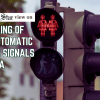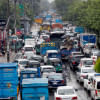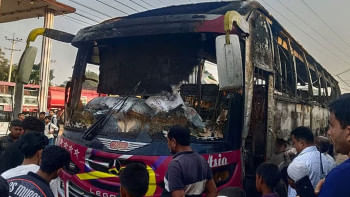Dhaka’s gridlock is a crisis of coordination

For millions of commuters in Dhaka, daily life is a relentless crawl due to the seemingly incurable congestion. The cost is measured not only in frustration but also in staggering economic losses. Comprehensive analyses and reports revealed that this inefficiency translated into an estimated loss of $6.5 billion in 2020 alone, with millions of productive hours vanishing into exhaust-filled air.
For decades, we looked for the solution in more flyovers, wider roads, and grand new projects. But it lies under the layers of failed plans and bureaucratic inertia, as Dhaka's traffic crisis is not a failure of engineering but a catastrophic failure of governance.
The city's transport sector is managed by an alphabet soup of agencies with unclear, overlapping, and often conflicting mandates. The Dhaka Transport Coordination Authority (DTCA) is meant to coordinate; the Bangladesh Road Transport Authority (BRTA) to regulate; the Dhaka Metropolitan Police (DMP) to enforce; and the city corporations (DNCC and DSCC) to build and maintain. Yet, in practice, these bodies operate in silos, often at cross-purposes. This institutional chaos ensures that even the most well-intentioned plans fail before they begin.
This is not a recent issue. As early as 1981, the Dhaka Metropolitan Area Integrated Urban Development Project (DMAIUDP) predicted the city's slide into severe congestion and recommended a north-south mass transit corridor. The plan was technically sound but drafted by a commission without the power to implement it. It was shelved, and its foresight ignored—setting a tragic precedent for decades of technically brilliant plans defeated by a lack of political will and executive authority.
Our planning also long failed to recognise the city's intrinsic nature. Dhaka was, and for much of its population remains, a city of non-motorised transport. Rickshaws once made up as much as 85 percent of vehicular traffic. Yet, for decades, policy has focused almost exclusively on private cars, often by sidelining or banning the very modes of transport that serve the majority and are best suited to our dense urban fabric.
Furthermore, over the past two decades, hundreds of crores have been spent on installing modern traffic signal systems. The World Bank-funded Dhaka Urban Transport Project (DUTP) installed them—they became dysfunctional. The Clean Air and Sustainable Environment (CASE) project upgraded them with solar panels and timers—they too failed. A recent pilot for an advanced traffic management system saw its crucial software stolen from a warehouse before it could even be installed.
Why do these expensive systems consistently fail? The city corporations own the hardware but lack manpower and resources for maintenance. Meanwhile, utility companies routinely dig up roads for repairs, severing underground signal cables without coordinating with police or city authorities.
The result is the absurd sight of traffic police manually directing vehicles. The only place in Dhaka where signals function reliably is the Cantonment area—where a single authority, the military, manages planning, operation, and maintenance. This proves that the problem is not technological but institutional: our civilian agencies simply cannot work together.
This dysfunction extends to the highest levels. The DTCA was legally established as the supreme coordinating body for all transport projects, yet it is routinely bypassed by powerful implementing agencies. The Dhaka Mass Transit Company Limited (DMTCL), responsible for the metro rail, has been publicly accused by the DTCA of ignoring its coordination mandate—allegedly due to bureaucratic rivalries and seniority clashes.
In the face of such governance failures, our default response has been to build. Thousands of crores have been poured into flyovers—the Mohakhali, Khilgaon, and Mayor Hanif structures stand as towering monuments to this approach. While they offer localised relief, these are expensive, tactical fixes that do little to address the strategic disease of an uncoordinated transport system. They are "concrete solutions" offering the illusion of progress while the underlying institutional decay deepens.
The metro rail and planned Bus Rapid Transit (BRT) lines represent a historic investment in the city's future. But this infrastructure will be squandered without a revolution in governance.
The path forward requires bold structural reform. The DTCA must be transformed from a toothless coordinating body into a powerful Urban Transport Authority (UTA), equipped with the legal authority, executive power, and bureaucratic seniority to enforce its mandate and compel inter-agency cooperation. Legally binding protocols must govern all work affecting road networks: a utility company that severs a signal cable without clearance should face immediate and substantial penalties. Coordination also must be mandatory.
We must also invest in institutional capacity, not just construction. The DTCA needs in-house technical expertise to guide and validate projects. The BRTA requires resources to enforce vehicle fitness standards and overhaul the chaotic bus route permit system. The DMP must be supported with reliable technology and modern training to manage Dhaka's streets effectively.
Finally, transport planning must be integrated with land use. The new mass transit corridors should catalyse smart urban growth. The Detailed Area Plan's vision for transit-oriented development must be rigorously implemented to ensure high-density, mixed-use communities around transit hubs. For too long, institutional silos and bureaucratic rivalries have held Dhaka hostage. It is time to stop building over the problem and start fixing the broken system beneath.
Dhrubo Alam is deputy transport planner at the Dhaka Transport Coordination Authority (DTCA).
Views expressed in this article are the author's own.
Follow The Daily Star Opinion on Facebook for the latest opinions, commentaries and analyses by experts and professionals. To contribute your article or letter to The Daily Star Opinion, see our guidelines for submission.

 For all latest news, follow The Daily Star's Google News channel.
For all latest news, follow The Daily Star's Google News channel. 










Comments